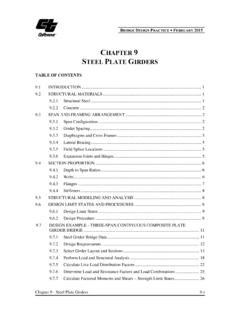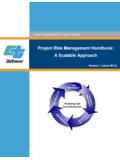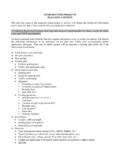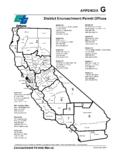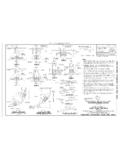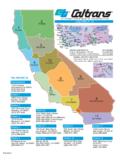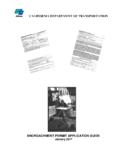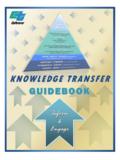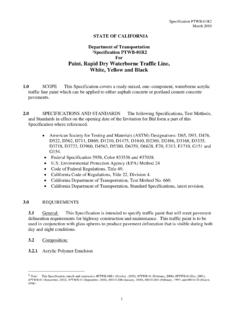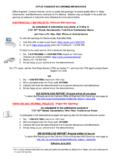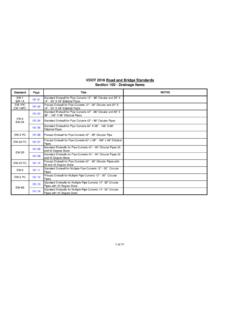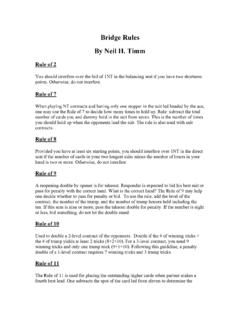Transcription of SECTION 14 - BEARINGS - Caltrans
1 bridge DESIGN SPECIFICATIONS APRIL 2000. SECTION 14 - BEARINGS . SCOPE longitudinal translation of abutting structure ele- ments. It may or may not provide for differential This SECTION contains requirements for the design and lateral translation or rotation. selection of structural BEARINGS . * Knuckle bearing A bearing in which a concave metal The selection and layout of the BEARINGS shall be surface rocks on a convex metal surface to provide consistent with the proper functioning of the bridge , and rotation capability about any horizontal axis. shall allow for deformations due to temperature and other Longitudinal The direction associated with the axis of time dependent causes.
2 The main structural trusses or girders in the bridge . The loads induced in the BEARINGS and structural mem- * Metal Rocker or Roller bearing A bearing which bers depend on the stiffness of the individual elements carries vertical load by direct contact between two and the tolerances achieved during fabrication and erec- metal surfaces and which accommodates movement tion. These influences shall be taken into account when by rolling of one surface with respect to the other. calculating design loads for the elements. Movable bearing A bearing that facilitates differen- Units used in this SECTION shall be taken as KIP, IN, tial horizontal translation of abutting structural ele- RAD, F and Shore Hardness, unless noted.
3 Ments in a longitudinal and/or lateral direction. It may or may not provide for rotation. Plain Elastomeric Pad (PEP) A pad made exclusively DEFINITIONS of elastomer. *Pot bearing A bearing which carries vertical load by +. Note: bearing definitions marked with an * are for compression on an elastomeric disc confined in a +. informational purposes only and are not covered in these steel cylinder and which accommodates rotations by +. specifications. deformations of the disc. PTFE/Elastomeric - A bearing which carries vertical +. bearing a structural device that transmits loads while load by contact stresses between a PTFE sheet and a +.
4 Facilitating translation and/or rotation. stainless steel mating surface that permits move- +. * Bronze bearing A bearing which displacements or ments by sliding of the PTFE over the stainless steel +. rotations take place by the slip of a bronze surface and accommodates rotation by deformation of the +. against a mating surface. elastomer. Cotton Duck Reinforcement Pad (CDP) A pad made PTFE Sliding bearing A bearing which carries verti- from closely spaced layers of elastomer and cotton cal load by contact stresses between a PTFE sheet or duck, bonded together during vulcanization.
5 Woven fabric and its mating surface, and which *Disc bearing A bearing which accommodates rota- permits movements by sliding of the PTFE over the tion by deformation of a single elastomeric disc, mating surface. molded from a urethane compound. It may contain a PTFE/Spherical - A bearing consisting of a PTFE sur- +. device for partially confining the disc against lateral faced concave plate and mating stainless steel con- +. expansion. vex plate which accommodate rotation through slid- +. *Double Cylindrical bearing A bearing made from two ing of the curved surfaces. +. cylindrical BEARINGS placed on top of each other with Rotation about the Longitudinal Axis Rotation about their axes at right angles to each other, in order to an axis parallel to the longitudinal axis of the bridge .
6 Provide rotation about any horizontal axis. Rotation about the Transverse Axis Rotation about an Fiberglass Reinforced Pad (FRP) A pad made from axis parallel to the transverse axis of the bridge . discrete layers of elastomer and woven fiberglass, RMS Root mean square bonded together during vulcanization. Sliding bearing - A bearing which accommodates move- * Fixed bearing A bearing which prevents differential ment by slip of one surface over another. SECTION 14 BEARINGS 14-1. bridge DESIGN SPECIFICATIONS APRIL 2000. Steel Reinforced Elastomeric bearing A bearing made Pm = Maximum compressive load considering all from alternate laminates of steel and elastomer, appropriate load combinations (kip).
7 Bonded together during vulcanization. R = Radius of curved sliding surface (in). Translation Horizontal movement of the bridge in the R0 = Radial distance from center of bearing to longitudinal or transverse direction. object, such as an anchor bolt, for which Transverse The horizontal direction normal to the clearance must be provided (in). longitudinal axis of the bridge . S = Shape factor of one layer of an elastomeric bearing Plan Area NOTATIONS =. Area of Perimeter Free to Bulge A = Plan area of elastomeric bearing (in2) LW. = for rectangular BEARINGS B = length of pad if rotation is about its transverse 2h rmax (L + W ).
8 Axis, or width of pad if rotation is about its without holes longitudinal axis (in). D. D = Diameter of the projection of the loaded = for circular BEARINGS without holes surface of the bearing in the horizontal plane 4h rmax (in) W = Width of the bearing in the transverse Dd = Diameter of the disc element (in) direction (in). dj = Diameter of the jth hole in an elastomeric = Effective angle of friction angle in PTFE. bearing BEARINGS = tan-1 (Hm/PD). E = Young's modulus (ksi). o = Maximum service horizontal displacement Ec = Effective modulus in compression of of the bridge deck (in).
9 Elastomeric bearing (ksi) s = Maximum shear deformation of the Es = Young's modulus for steel (ksi) elastomer (in). e = Eccentricity of loading on a bearing (in) = Instantaneous compressive deflection of Fsr = Allowable fatigue stress range for over bearing (in). 2,000,000 cycles (ksi) m = Maximum compressive deflection of Fy = Yield strength of the least strong steel at the bearing (in). contact surface (ksi) = Instantaneous compressive strain of a plain G = Shear modulus of the elastomer (ksi) elastomeric pad Hm = Maximum horizontal load on the bearing or i = Instantaneous compressive strain ith elastomer restraint considering all appropriate load layer of a laminated elastomeric bearing combinations (kip) = Component of maximum service rotation in hri = Thickness of ith elastomeric layer in direction of interest on an elastomeric elastomeric bearing (in)
10 bearing under load for Article hrmax= Thickness of thickest elastomeric layer in D = Maximum rotation due to dead load (rad). elastomeric bearing (in) L = Maximum rotation due to live load hrt = Total elastomer thickness in an elastomeric m,x = Maximum rotation considering all bearing (in) appropriate load and deformation hs = Thickness of steel laminate in combinations about transverse axis (rad). steel-laminated elastomeric bearing (in) m,z = Maximum rotation considering all I = Moment of inertia (in4) appropriate load and deformation L = Length of a rectangular elastomeric bearing combinations about longitudinal axis (rad).
